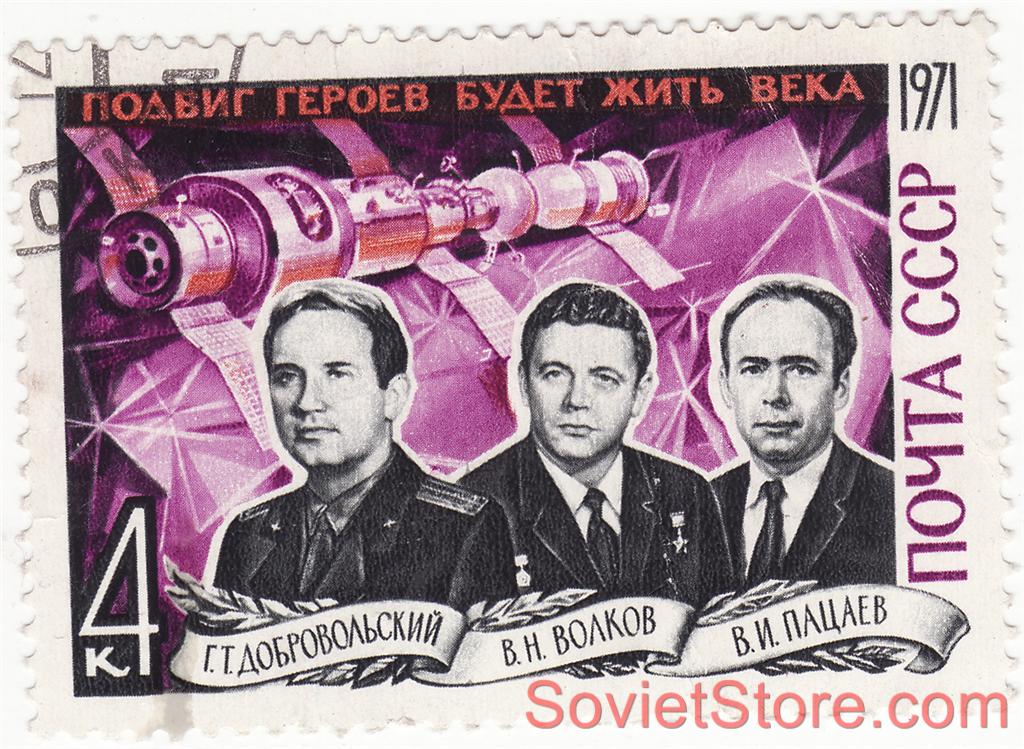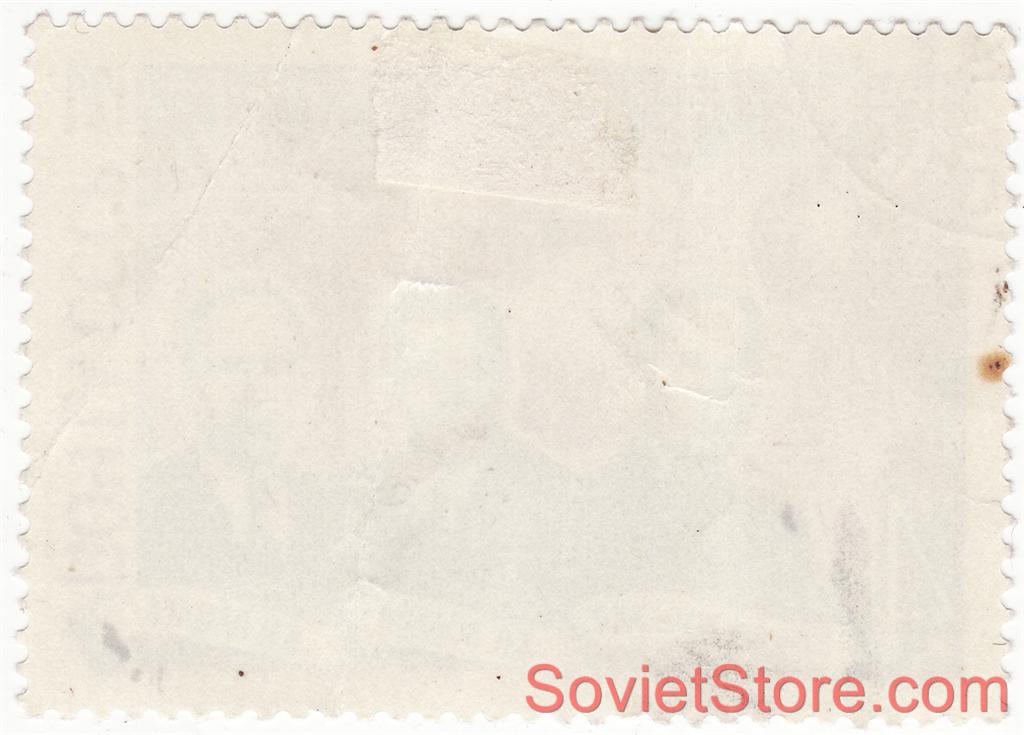SearchProduct Type
|
Add us to: Favorite Stores Item's weight: less then 1 g.
Stamp Authenticity Since 1939 till 1990 Lithuania suffered 3 occupations: 1 German (1941-1944) and 2 Soviet (1939-1941, 1944-1990), one of which lasted 46 years. In WWII occupations were based on violent battles between Germans and Russians. These historical events left a lot of stuff behind them selves. Almost every family in Lithuania has something left, related to USSR history in their forgotten drawers. So we are just traveling around lithuanian countrysides and collecting this memorabilia. Item is original, genuine, authentic, unique, not a copy or replica - has 2-12 decades of it's own unique history.
Soyuz 11
Soyuz 11 was the first successful visit to the world's first space station, Salyut 1. However the mission ended in disaster when the crew capsule depressurised during preparations for re-entry, killing the three-man crew.[2] This accident resulted in the first and to date only astronaut deaths to occur in space (not in high atmosphere). The cosmonauts aboard Soyuz 11 were Vladislav Volkov, Georgi Dobrovolski and Viktor Patsayev.[3][4][5] CrewNumber in parentheses indicates number of spaceflights by each individual prior to and including this mission.
The prime crew for Soyuz 11 consisted of Alexei Leonov, Valeri Kubasov and Pyotr Kolodin. A medical X-ray examination four days before launch suggested that Kubasov might have tuberculosis, and according to the mission rules, the prime crew was replaced with the back-up crew. For Dobrovolski and Patsayev, this was to be their first space mission. After the failure of Salyut 2 to orbit, Kubasov and Leonov were reassigned to Soyuz 19 for the Apollo-Soyuz Test Project in 1975. Reserve crew
Mission parameters
Mission highlightsThe Soyuz spacecraft was launched on June 6, 1971, from Baikonur Cosmodrome in central Kazakh SSR. Several months earlier, the first mission to the Salyut, Soyuz 10, had failed to successfully dock with the station.[6] Soyuz 11, however, successfully docked with Salyut 1 on June 7 and the cosmonauts remained on-board for 22 days, setting space endurance records that would hold until the American Skylab 2 mission in May-June 1973.[2] Upon first entering the station, the crew encountered a smokey and burnt atmosphere and after replacing part of the ventilation system spent the next day back in their Soyuz until the air cleared. Their stay in Salyut was productive, including live television broadcasts. However, a fire broke out on day 11 of their stay causing mission planners to consider abandoning the station. The planned highlight of the mission was to have been the observation of an N-1 booster launch, but the launch was postponed. The crew also found that using the exercise treadmill as they were required to do twice a day caused the whole station to vibrate. Pravda released news of the mission and regular updates while it was in progress. Death of crewOn June 30, 1971, after an apparently normal re-entry of the capsule of the Soyuz 11 mission, the recovery team opened the capsule to find the crew dead.[1][2][7] It quickly became apparent that they had suffocated. The fault was traced to a breathing ventilation valve, located between the orbital module and the descent module, that had been jolted open as the descent module separated from the service module.[8][9] The two were held together by explosive bolts designed to fire sequentially, but in fact, they fired simultaneously while over France.[8] The force of this caused the internal mechanism of the pressure equalization valve to loosen a seal that was usually discarded later, and normally allowed automatic adjustment of the cabin pressure.[1][8] When the valve opened at 168 kilometers (104 mi), the gradual loss of pressure was fatal within seconds.[8][10] By 935 seconds after the retrofire, the cabin pressure was zero, and remained there until the capsule hit the earth's atmosphere.[8] Located beneath the cosmonaut's couches, the valve was impossible to locate and block the leak before the air was lost. It is estimated that the cabin lost all its atmosphere in about 30 seconds. Flight recorder data from the single cosmonaut outfitted with biomedical sensors showed death occurred within 40 seconds of pressure loss. Film later declassified showed support crews attempting CPR on the cosmonauts.[11] They attempted to save the cosmonauts in the hope that the decompression accident occurred in a time-frame that might have allowed for some of them to be saved. Current understanding of exposure to vacuum, however, shows this to be impossible, as vacuum exposure leads to rapid deoxygenation of the blood, pulmonary hemorrhaging, and brain death within two minutes of continuous exposure.[8] The cosmonauts were given a large state funeral and buried in the Kremlin Wall Necropolis at Red Square, Moscow near the remains of Yuri Gagarin.[2] U.S. astronaut Tom Stafford was one of the pallbearers. They were also each posthumously awarded the Hero of the Soviet Union medal. Craters on the Moon were named after the three cosmonauts. The Soyuz spacecraft was extensively redesigned after this incident to carry only two cosmonauts. The extra room meant that the crew could wear space suits during launch and landing.[12] A Soyuz capsule would not hold three cosmonauts again until the Soyuz-T redesign in 1980, which freed enough space for three cosmonauts in lightweight pressure suits to travel in the capsule. References
Georgiy Timofeyevich Dobrovolskiy
Georgiy Timofeyevich Dobrovolskiy (Russian: Георгий Тимофеевич Добровольский; June 1, 1928, Odessa, Ukrainian SSR – June 30, 1971) was a Soviet cosmonaut. He flew on the Soyuz 11 mission and had the unfortunate distinction of being part of the first acknowledged Soviet crew to die during a space flight. After a normal re-entry, the capsule was opened and the crew was found dead. It was discovered that a valve had opened just prior to leaving orbit that had allowed the capsule's atmosphere to vent away into space, suffocating the crew. Dobrovolskiy's ashes were inurned in the Kremlin Wall on the Red Square in Moscow.
Vladislav Nikolayevich Volkov
Vladislav Nikolayevich Volkov (Russian: Владислав Николаевич Волков; b. November 23, 1935, Moscow – d. June 30, 1971) was a Soviet cosmonaut who flew on the Soyuz 7 and Soyuz 11 missions. Graduated from Moscow Air Force Institute, 1959. As aviation engineer at Korolyov Design bureau was involved in the development of the Vostok and Voskhod spacecrafts prior to his selection as a cosmonaut. He flew aboard Soyuz 7 in 1969 and spent 23 days on Salyut 1, the world's first space station, in 1971. He was a member of the second crew to die during a space flight on Soyuz 11. After a normal re-entry, the capsule was opened and the crew was found dead. It was discovered that a valve had opened just prior to leaving orbit that had allowed the capsule's atmosphere to vent away into space, suffocating the crew. Vladislav Volkov was decorated twice as the Hero of the Soviet Union (first on October 22, 1969 and posthumously on June 30, 1971). He was also awarded the Order of Lenin. The Volkov crater on the Moon is named in his honor. A street in Moscow is named after him. Vladislav Volkov's ashes were inurned in the Kremlin Wall on the Red Square in Moscow. In the movie "Virus" (1999), an alien intelligence inhabits the computer system of the research vessel "Akademic Vladislav Volkov" via a transmission from space. According to Brian Harvey's book Russia In Space, there was also a real Soviet communications ship called the Vladislav Volkov, but it was sold by the Russian government following the fall of the USSR. The Cosmonaut Volkov variety of heirloom tomato is also named for him.
Viktor Ivanovich Patsayev
Viktor Ivanovich Patsayev (Russian: Виктор Иванович Пацаев; June 19, 1933, Aktyubinsk – June 30, 1971) was a Soviet cosmonaut who flew on the Soyuz 11 mission and had the unfortunate distinction of being part of the second crew to die during a space flight. Onboard space station Salyut 1 he operated the Orion 1 Space Observatory (see Orion 1 and Orion 2 Space Observatories), he became the first man to operate a telescope outside the Earth's atmosphere. After a normal re-entry, the capsule was opened and the crew was found dead. It was discovered that a valve had opened just prior to leaving orbit that had allowed the capsule's atmosphere to vent away into space, suffocating the crew. One of Patsayev's hands was found to be bruised, and he may have been trying to shut the valve manually at the time he lost consciousness. Patsayev's ashes were inurned in the Kremlin Wall on the Red Square in Moscow.
The free listing tool. List your items fast and easy and manage your active items. On Jul-02-08 at 16:19:48 PDT, seller added the following information:
| Return
Items must be returned within 30 days .
Refund will be given as Money back. Refund policy details: Return is accepted at any reason. Item(s) must arrive to us not later then 30 days after it was shipped out (you will be informed about this immediately after it will be done). Returned items must be the same item in the exact same condition as originally shipped. Refunds are for the final eBay item purchase price only, less a 10% restocking fee. Shipping costs, insurance, and handling charges (if any) are non refundable. Returns must be shipped insured. Shipping
Payment Method
Insurance
Not Offered (Domestic)
|
Shopping Cart |
|||||||||||||||||||||||||||||||||||||||||||||||||||||||||||||||||||||||||||||||||||||||||||||||||||||||||||||||||||||||||||||||||||||||||||||||||||||||||||||||||||||||||||




